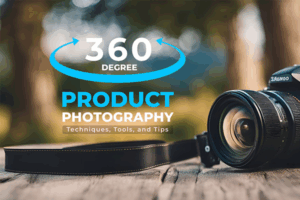The Role of 360-Degree Product Photography in Industrial Marketing
 The Role of 360-Degree Product Photography in Industrial Marketing
The Role of 360-Degree Product Photography in Industrial Marketing
In the world of industrial marketing, businesses face a unique challenge: how to showcase complex products that are often large, technical, and require in-depth understanding. Traditional product photography—while useful—often falls short of capturing the intricacies and details that industrial buyers need. Enter 360-degree product photography, a cutting-edge tool that is transforming the way industrial products are presented online and driving more informed purchase decisions.
What is 360-Degree Product Photography?
Unlike static images, 360-degree photography allows viewers to interact with a product image by rotating it in all directions. Users can zoom in, spin the product, and explore every angle as if they were physically holding it. For industries dealing with machinery, tools, or technical components, this interactive experience bridges the gap between online viewing and hands-on inspection.
Why Industrial Businesses Need It
1. Showcasing Complex Products Effectively
Industrial products often have intricate details—gears, valves, finishes, or configurations—that are hard to communicate through flat photos. A 360-degree view lets buyers analyze these details in real time, helping them better understand how the product looks and functions.
2. Builds Buyer Confidence
When buyers can inspect a product from every angle, it reduces uncertainty. This is especially crucial in B2B environments where purchases involve significant investment. By providing a transparent, interactive view, businesses foster trust and confidence in their offerings.
3. Reduces Return Rates
One of the leading causes of product returns is a mismatch between customer expectations and the actual product. 360-degree images provide a comprehensive visual representation, ensuring customers know exactly what they are buying, which minimizes returns and saves costs.
Enhancing the Customer Experience
In a digital-first era, customer experience is king. Industrial buyers—like all consumers—are now accustomed to engaging, interactive content. A website offering 360-degree product photography immediately feels modern and customer-centric. It encourages visitors to spend more time exploring products, increasing the likelihood of conversion.
SEO and Engagement Benefits
360-degree images aren’t just eye-catching—they’re also great for SEO. Search engines value interactive content because it boosts user engagement metrics like time-on-page and reduces bounce rates. The longer visitors interact with your product visuals, the more signals you send to Google about the value of your site.
Competitive Advantage in Industrial Marketing
In industries where competition is fierce and differentiation is difficult, adopting 360-degree product photography sets your brand apart. It positions your company as innovative and customer-focused, which can be a deciding factor when prospects are choosing between suppliers.
How to Get Started
Implementing 360-degree photography requires a mix of technology and expertise. Industrial businesses can:
- Invest in a professional photography setup with turntables and high-resolution cameras.
- Partner with agencies specializing in 3D and 360-degree imaging.
- Ensure their website supports interactive media for seamless integration.
The Future of Product Visualization
As technologies like AR (Augmented Reality) and VR (Virtual Reality) evolve, 360-degree photography will likely serve as a foundation for even more immersive experiences. Imagine industrial buyers virtually placing your machinery in their factory floor before making a purchase decision.
Conclusion
360-degree product photography is no longer a luxury; it’s becoming a necessity in industrial marketing. By offering transparency, enhancing engagement, and improving buyer confidence, it directly contributes to higher sales and stronger customer relationships. For industrial businesses looking to future-proof their marketing strategies, the time to adopt this innovative tool is now.
Related Posts
How AI Is Reshaping SEO & Digital Marketing
In 2025, artificial intelligence (AI) is no longer a futuristic concept or optional add-on in…
How to Choose the Right Hosting Plan for Your Business Website
In today’s digital world, your website is more than just an online brochure — it…
Why Manufacturers and Exporters Need the Best SEO Company in Ahmedabad
As a trusted partner for industrial businesses, Kaival Infotech understands the challenges manufacturers and exporters…

